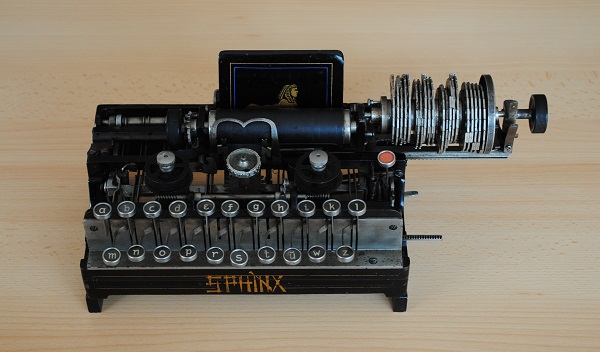Ein Verschlüsselungsgerät, das zum Verschlüsseln gar nicht geeignet ist? Bei der Sphinx schien dies der Fall zu sein. Nach Jahren des Rätselratens gibt es nun erstmals eine plausible Vermutung, was es mit dieser seltsamen Maschine auf sich hat.
„Top Secret – Vom Verschlüsseln geheimer Botschaften“ ist der Titel einer Sonderausstellung im Schreibmaschinen-Museum Partschins (Südtirol), die gestern eröffnet wurde. Der Veranstalter hatte mich aus diesem Anlass zu einem Vortrag eingeladen, was in dieser schönen Gegend ein absolutes Vergnügen war. Da gleichzeitig das 9. Internationale Schreibmaschinen-Sammlertreffen stattfand, hatte ich ein fachkundiges Publikum – schließlich gibt es zwischen Schreibmaschinen und Verschlüsselungsmaschinen zahlreiche Berührungspunkte.
Der Schweizer Sammler Stefan Beck, der in Pfäffikon selbst ein Schreibmaschinen-Museum betreibt, hatte eine interessante Maschine dabei: die Sphinx. Dabei handelt es sich um eine umgebaute Schreibmaschine. Laut Vorbesitzer sollte der Umbau das Gerät zu einer Verschlüsselungsmaschine machen. Die Sphinx ist ein Einzelstück. Sie ist nicht mit der gleichnamigen Schreibmaschine von Samuel Gertsch und nicht mit dem gleichnamigen Verschlüsselungsgerät von Albert Gentet zu verwechseln. Stefan Beck schätzt, dass das Gerät um 1910 gebaut wurde.
Auf den ersten Blick ist die Sache klar: Die aus 20 unregelmäßig geformten Scheiben bestehende Trommel auf der rechten Seite sorgt dafür, dass nicht der getippte, sondern ein anderer Buchstabe gedruckt wird – so entsteht die Verschlüsselung. Auf den zweiten Blick ergibt dies jedoch keinen Sinn, denn die Trommel ist nicht mit den Drucktypen verbunden. Die Maschine kann daher nur Klartext schreiben. Als ich die Sphinx vor einigen jahren zum ersten Mal sah, konnte ich mir keinen Reim auf dieses scheinbar nutzlose Gerät machen. Anderen erging es ebenso.
Beim Sammlertreffen in Partschins kam ich mit Fritz Niemann, Experte für alte Technik, über die Sphinx ins Gespräch. Nach einigen Diskussionen mit Stefan Beck und mir kam Niemann schließlich auf folgende Idee: Die Scheibentrommel ist nicht dazu da, die Buchstabentypen zu beinflussen, sondern sie soll dem Benutzer anzeigen, welche Taste er anschlagen soll. Allerdings ist mit dem besten Willen nicht zu erkennen, wie das Anschlagen der Tasten reproduzierbar sein soll (bei einer Verschlüsselungsmaschine müsste das so sein, sonst lässt sich die Verschlüsselung nicht rückgängig machen). Auch die Scheibentrommel sieht nicht so aus, als ob man mit ihr auf einfache Weise zweimal die gleiche Einstellung konfigurieren könnte.
Es bleibt also nur eine Erklärung: Die Sphinx war als Zufallsgenerator (vermutlich für kryptologische Schlüssel) gedacht. Sie produzierte zwanzigstellige Buchstabenfolgen, wobei nach jeweils fünf Buchstaben ein Zwischenraum erschien – also etwa YJSJG SAHHK QXHQW SKKPD. Wenn das Papier einen Schritt nach links rückte, rückte auch die Trommel nach links, und eine neue Scheibe kam in die aktive Position. Dort musste sie von Hand bis zum Anschlag gedreht werden, dann konnte man den Zufallsbuchstaben ablesen. Nach 20 Buchstaben musste man die Trommel neu konfigurieren, indem man die Scheiben in der Reihenfolge veränderte und verdrehte.
Das folgende Video zeigt, wie Fritz Niemann die Maschine bedient (leider ohne Ton):
Nun stellen sich natürlich einige Fragen: Wurde die Sphinx wirklich so verwendet? Wozu nutzte man die Zufallszahlen? Wann kam die Sphinx zum Einsatz? Wer etwas weiß, möge sich melden.
Follow @KlausSchmeh





Kommentare (15)